

Orangutan Foundation International Australia. Orangutan Foundation International Australia. Official Orangutan Foundation International Website. Save the Orangutan : Lone Dröscher Nielsen : The Great Ape Escape. The Orangutan Project - Adopt an Orphan, Protect and Safeguard Rainforest, Orangutan Facts. Make a Donation. Orangutans are critically endangered in the wild because of rapid deforestation and the expansion of palm oil plantations.

They need our protection. It costs around US $3,000 a year to rescue, rehabilitate and release each orangutan. YOU can make a difference! Your donation will ensure that we can continue this important work. With your help, we can give orangutans a future. Orangutan Outreach is a registered 501(c)(3) US charity. On behalf of the orangutans, thank you for your support,Richard Zimmerman {:(|} Executive Director Orangutan Outreach Donate via Authorize.net Donate via PayPal Donate via Network for Good Learn more about this safe, secure way to donate online-- and make a donation today! Donate via Dwolla Dwolla is an amazing new payment system that allows you to do direct bank transfers in the US with a flat fee of 25¢. Donate via the Orangutan Outreach Facebook Cause. The RSPO sustainable palm oil. Orangutan Conservancy. Orangutans Face Extinction A crisis exists for orangutans.
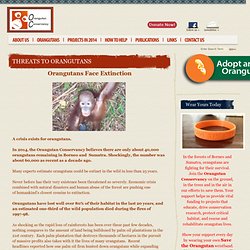
In 2014, the Orangutan Conservancy believes there are only about 40,000 orangutans remaining in Borneo and Sumatra. Shockingly, the number was about 60,000 as recent as a decade ago. Many experts estimate orangutans could be extinct in the wild in less than 25 years. Never before has their very existence been threatened so severely. Threats to Orangutans. At the turn of the century, orangutan populations in Borneo and Sumatra numbered in the hundreds of thousands, inhabiting endless expanses of untouched tropical rainforest.
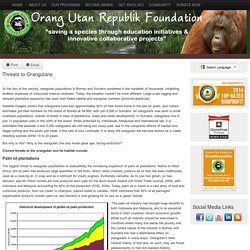
Today, the situation couldn’t be more different. Large scale logging and rampant plantation expansion has seen both forest habitat and orangutan numbers plummet drastically. Deforestation: Facts, Causes & Effects. Deforestation is the permanent destruction of forests in order to make the land available for other uses.
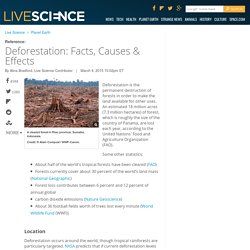
An estimated 18 million acres (7.3 million hectares) of forest, which is roughly the size of the country of Panama, are lost each year, according to the United Nations' Food and Agriculture Organization (FAO). Some other statistics: About half of the world's tropical forests have been cleared (FAO) Forests currently cover about 30 percent of the world’s land mass (National Geographic) Forest loss contributes between 6 percent and 12 percent of annual global carbon dioxide emissions (Nature Geoscience) About 36 football fields worth of trees lost every minute (World Wildlife Fund (WWF)) Deforestation occurs around the world, though tropical rainforests are particularly targeted. NASA predicts that if current deforestation levels proceed, the world's rainforests may be completely in as little as 100 years. Error loading player: No playable sources found Weather vs. Impact of habitat loss on species. Habitat loss is probably the greatest threat to the variety of life on this planet today.
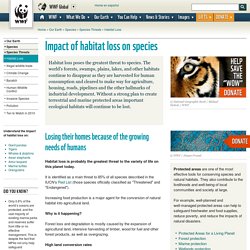
It is identified as a main threat to 85% of all species described in the IUCN's Red List (those species officially classified as "Threatened" and "Endangered"). Increasing food production is a major agent for the conversion of natural habitat into agricultural land. Why is it happening? Orangutans. Physical description The orangutan is the world's largest tree-climbing mammal.
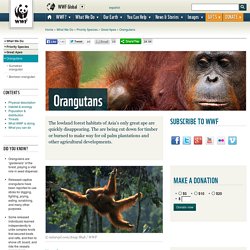
The animals have a characteristic ape-like shape, shaggy reddish fur and grasping hands and feet. Their long arms that can reach as much as 2 meters in length. Habitat Loss. Habitat loss—due to destruction, fragmentation or degradation of habitat—is the primary threat to the survival of wildlife in the United States.
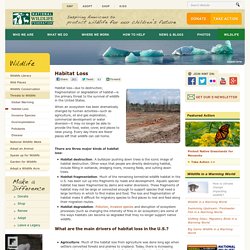
When an ecosystem has been dramatically changed by human activities—such as agriculture, oil and gas exploration, commercial development or water diversion—it may no longer be able to provide the food, water, cover, and places to raise young. Every day there are fewer places left that wildlife can call home. There are three major kinds of habitat loss: Habitat destruction: A bulldozer pushing down trees is the iconic image of habitat destruction. Orangutans and oil palm plantations. Of approximately 11 million hectares of oil palm plantations globally, about 6 million hectares are found in Indonesia1 (in 2006) - and counting.

But in many places, these plantations are taking over rainforests, the natural habitat of endangered species such as orangutans. Habitat conversion from natural forests to oil palm plantations has been shown to have a devastating impact on tropical forests, along with plants and animals that depend on them. For example, there are nearly 80 mammal species in Malaysia's primary forests, just over 30 in disturbed forests, and only 11 or 12 in oil palm plantations.2 A similar loss in diversity occurs for insects, birds, reptiles, and most important of all, for soil microorganisms. Find out more. Our projects – Sumatran Orangutan Society. SOS works to protect orangutans, their forests and their future.
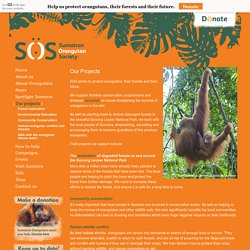
We support frontline conservation programmes and tirelessly campaign on issues threatening the survival of orangutans in the wild. As well as planting trees to restore damaged forests in the beautiful Gunung Leuser National Park, we work with the local people of Sumatra, empowering, educating and encouraging them to become guardians of this precious ecosystem.
Field projects we support include: The restoration of degraded forests in and around the Gunung Leuser National Park More than a million trees have already been planted to replace some of the forests that have been lost. Community conservation.